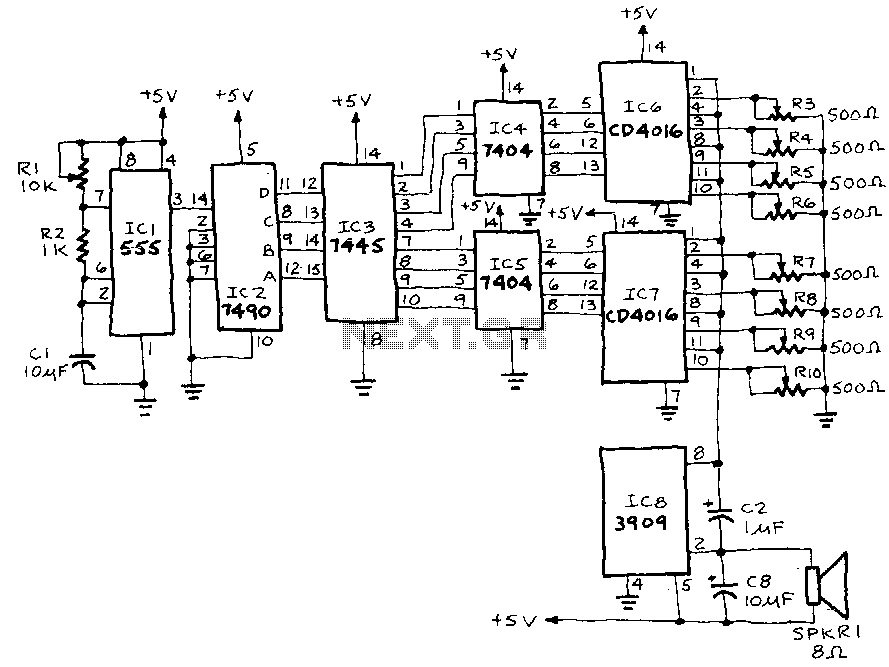
Electronic-music

IC1, a 555 timer, is configured as an astable multivibrator to generate a signal that triggers IC2, a 7490 decade counter. This counter produces a BCD output that is connected to IC3, a 7445 BCD-to-decimal decoder/driver. The output from IC3 is inverted by two hex inverters, IC4 and IC5. The outputs of IC4 and IC5 are inputted to control pins on IC6 and IC7, CD4016 CMOS quad bilateral switches. As these switches open and close, various resistances (set by potentiometers R3 through R10) are inserted into the sound-generating circuit formed by IC5. The frequency at the outputs of IC6 and IC7 is adjusted to different rates using potentiometers R3 through R10 to produce the desired tones. Capacitors can be placed in series with the potentiometers to create a sloping sound instead of a straight tone. The negative-going output signals from IC6 and IC7 are routed through a common bus to pin 5 of IC5.
The circuit described utilizes a 555 timer (IC1) configured as an astable multivibrator, which operates continuously to generate a square wave signal. This signal serves as the clock input for the 7490 decade counter (IC2), which counts in binary-coded decimal (BCD) format. The BCD output from IC2 is then fed into the 7445 decoder/driver (IC3), which translates the BCD input into a corresponding decimal output.
The outputs from IC3 are directed to two hex inverters (IC4 and IC5), which invert the signals to provide control inputs for two CD4016 CMOS quad bilateral switches (IC6 and IC7). These switches are employed to control the insertion of variable resistances into the sound-generating circuit, which is based on IC5. The resistances are adjusted using potentiometers (R3 through R10), allowing for fine-tuning of the sound characteristics produced by the circuit.
To achieve different audio frequencies, the outputs from IC6 and IC7 can be adjusted by varying the potentiometers. Incorporating capacitors in series with the potentiometers can modify the waveform, producing a sloping sound profile rather than a pure tone. The negative-going output signals from the switches (IC6 and IC7) are combined and sent through a common bus to pin 5 of IC5, which is likely configured to generate audio signals. This arrangement allows for dynamic sound modulation and the creation of various audio effects based on the resistance settings and frequency adjustments made through the circuit's components.ICl, a 555 timer, is set up as an astable multivibrator to produce the signal that triggers IC2, a 7490 decade counter. That IC, in turn, produces a BCD output that is fed to IC3, a 7445 BCD-to-decimal decoder/driver. IC3"s output is inverted by two hex inverters, IC4 and IC5. The outputs of IC4 and IC5 are inputted to control pins on IC6 and IC7, CD4016 CMOS quad bilateral switches.
As those switches open and close, different resistances (as set by potentiometers R3 through RlO) are inserted into the sound-generating circuit made from ICS. The frequency atthe outputs of IC6 and !C7 are adjusted to various rates, using potentiometers R3 through RIO, to produce the desired tones. Capacitors can be placed in series with the potentiometers to produce a sloping sound instead of a straight tone.
The negative-going output signals of IC6 and IC7 are fed through a common bus to pinS of ICS.
The circuit described utilizes a 555 timer (IC1) configured as an astable multivibrator, which operates continuously to generate a square wave signal. This signal serves as the clock input for the 7490 decade counter (IC2), which counts in binary-coded decimal (BCD) format. The BCD output from IC2 is then fed into the 7445 decoder/driver (IC3), which translates the BCD input into a corresponding decimal output.
The outputs from IC3 are directed to two hex inverters (IC4 and IC5), which invert the signals to provide control inputs for two CD4016 CMOS quad bilateral switches (IC6 and IC7). These switches are employed to control the insertion of variable resistances into the sound-generating circuit, which is based on IC5. The resistances are adjusted using potentiometers (R3 through R10), allowing for fine-tuning of the sound characteristics produced by the circuit.
To achieve different audio frequencies, the outputs from IC6 and IC7 can be adjusted by varying the potentiometers. Incorporating capacitors in series with the potentiometers can modify the waveform, producing a sloping sound profile rather than a pure tone. The negative-going output signals from the switches (IC6 and IC7) are combined and sent through a common bus to pin 5 of IC5, which is likely configured to generate audio signals. This arrangement allows for dynamic sound modulation and the creation of various audio effects based on the resistance settings and frequency adjustments made through the circuit's components.ICl, a 555 timer, is set up as an astable multivibrator to produce the signal that triggers IC2, a 7490 decade counter. That IC, in turn, produces a BCD output that is fed to IC3, a 7445 BCD-to-decimal decoder/driver. IC3"s output is inverted by two hex inverters, IC4 and IC5. The outputs of IC4 and IC5 are inputted to control pins on IC6 and IC7, CD4016 CMOS quad bilateral switches.
As those switches open and close, different resistances (as set by potentiometers R3 through RlO) are inserted into the sound-generating circuit made from ICS. The frequency atthe outputs of IC6 and !C7 are adjusted to various rates, using potentiometers R3 through RIO, to produce the desired tones. Capacitors can be placed in series with the potentiometers to produce a sloping sound instead of a straight tone.
The negative-going output signals of IC6 and IC7 are fed through a common bus to pinS of ICS.